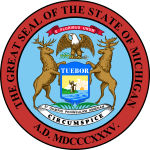| ||||||||||||||||||||||||||
All 14 Michigan votes to the Electoral College | ||||||||||||||||||||||||||
|---|---|---|---|---|---|---|---|---|---|---|---|---|---|---|---|---|---|---|---|---|---|---|---|---|---|---|
| ||||||||||||||||||||||||||
 County Results
Taft 50-60% 60-70% 70-80% 80-90% 90-100%
| ||||||||||||||||||||||||||
| ||||||||||||||||||||||||||
| Elections in Michigan |
|---|
 |
The 1908 United States presidential election in Michigan took place on November 3, 1908, as part of the 1908 United States presidential election. Voters chose 14[1] representatives, or electors, to the Electoral College, who voted for president and vice president.
Following the Panic of 1893 and the Populist movement, Michigan would turn from a competitive Republican-leaning state into a rigidly one-party polity dominated by the Republican Party.[2] The dominance of the culture of the Lower Peninsula by anti-slavery Yankees[3] would be augmented by the turn of formerly Democratic-leaning German Catholics away from that party as a result of the remodelled party's agrarian and free silver sympathies, which became rigidly opposed by both the upper class and workers who followed them.[4] The state Democratic Party was further crippled via the Populist movement severing its critical financial ties with business and commerce in Michigan as in other Northern states.[5] A brief turn of the strongly evangelical Cabinet Counties toward the Populist movement in the 1896 presidential election would reverse itself following the return to prosperity under President William McKinley, so that these joined in Republican hegemony until the Great Depression. McKinley would also later beat Bryan in the state again four years later.
In the 1894 elections, the Democratic Party lost all but one seat in the Michigan legislature,[6] and the party would only make minor gains there for the next third of a century. Unlike the other states of the Upper Midwest, the Yankee influence on the culture of the Lower Peninsula was so strong that left-wing third parties did not provide significant opposition to the Republicans, nor was there more than a moderate degree of coordinated factionalism within the hegemonic Michigan Republican Party.[7]
With Michigan's solid one-party GOP status not threatened, neither William Howard Taft nor Bryan campaigned in the state, and the only straw vote suggested that Republican nominee Taft from Ohio would carry the state over third-time Democratic candidate Nebraskan William Jennings Bryan by between fifty and one hundred thousand votes[8] — still a halving of the huge margin Theodore Roosevelt had gained over Alton B. Parker four years previously. However, the Santa Ana Register estimate proved extremely conservative, for the Republican ticket received nearly 62 percent of the vote, while the Democrats received only 32 percent.[9]
With 61.93 percent of the popular vote, Michigan would be Taft's third strongest victory in terms of popular vote percentage after Vermont and Maine.[10] This was the second time, after the previous election, that any party carried every county in the state.
- ^ "1908 Election for the Thirty-First Term (1909-1913)". Retrieved April 3, 2018.
- ^ Burnham, Walter Dean (December 23, 1981). "The System of 1896: An Analysis". The Evolution of American Electoral Systems. Bloomsbury Academic. pp. 178–179. ISBN 0313213798.
- ^ English, Gustavus P.; Proceedings of the Ninth Republican National Convention (1888), p. 234
- ^ Sundquist, James (December 2010). Politics and Policy: The Eisenhower, Kennedy, and Johnson Years. Brookings Institution Press. p. 526. ISBN 978-0815719090.
- ^ Rogowski, Ronald (2020). Commerce and Coalitions: How Trade Affects Domestic Political Alignments. Princeton University Press. ISBN 978-0691219431.
- ^ "Swamped! The Democrats Drowned Out by a Tremendous Republican Tidal Wave". The L'Anse Sentinel. L'Anse. November 10, 1894. p. 1.
- ^ Hansen, John Mark; Shigeo, Hirano; Snyder Jr, James M. (February 27, 2017). "Parties within Parties: Parties, Factions, and Coordinated Politics, 1900-1980". In Gerber, Alan S.; Schickler, Eric (eds.). Governing in a Polarized Age: Elections, Parties, and Political Representation in America. Cambridge University Press. pp. 165–168. ISBN 978-1-107-09509-0.
- ^ "Taft Will Get Michigan". Santa Ana Register. Santa Ana, California. October 22, 1908. p. 1.
- ^ "1908 Presidential General Election Results — Michigan". Retrieved April 3, 2018.
- ^ "1908 Presidential Election Statistics". Dave Leip’s Atlas of U.S. Presidential Elections. Retrieved March 5, 2018.

